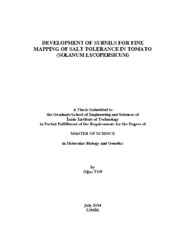Please use this identifier to cite or link to this item:
https://hdl.handle.net/11147/4252| Title: | Development of Subnils for Fine Mapping of Salt Tolerance in Tomato (solanum Lycopersicum) | Other Titles: | Domateste (solanum Lycopersicum) Tuza Toleransın Yüksek Çözünürlükte Haritalanması için Subnıls Hatların Geliştirilmesi | Authors: | Top, Oğuz | Advisors: | Doğanlar, Sami | Keywords: | Fine mapping Tomato SubNILs Salinity |
Publisher: | Izmir Institute of Technology | Abstract: | Salt tolerance is a complex trait that is not easily bred into plants. Salt tolerance can be manifested in several ways such as the ability to increase shoot and/or root mass despite salt stress, a greater than normal accumulation of antioxidants like phenolic compounds and flavonoids, and an improved ability to exclude sodium ions. In previous work, S. lycopersicum M82, S. pennellii LA716 and a S. pennellii IL population were evaluated for growth and their levels of antioxidant activity and content under both control and salt stress conditions (150 mM NaCl) (Frary et al., 2010). These data were used to identify QTLs responsible for controlling antioxidant parameters under both control and stress conditions. Salt tolerance characteristics were observed in IL11-1, IL6-1 and IL7-4-1. The aim of this project was the development of subNILs for fine mapping of salt tolerance related traits within these introgression regions. To this end, each Solanum pennellii IL was crossed with Solanum lycopersicum M82 to produce F2 populations of approximately 1600 individuals for IL6-1, 1600 individuals for IL7-4-1 and 3000 individuals for IL11-1. These individuals were screened with molecular markers that delimit the 30-40 cM introgressions contained in each line. Because of low number of recombinants in IL6-1 and IL7-4-1 populations, they were not selfed to produce subNILs for future analysis. Recombinant F2 plants in IL11-1 population were self-pollinated to generate F3 recombinant families. Each F3 recombinant plant was characterized with several codominant molecular markers in the introgression region. 228 homozygous recombinant F3 plants and 620 heterozygous recombinant plants were identified. At the end of this work, fine mapping populations were developed and in the future they will be grown hydroponically under both control and salt conditions and will be screened for physiological, mineral and biochemical parameters. By statistical comparison between control and salt-treated plants, it will then be possible to identify which recombinants carry regions with significant effects on the various salt tolerance responses. Thus, each gene will be narrowed down to a particular chromosome region. | Description: | Thesis (Master)--Izmir Institute of Technology, Molecular Biology and Genetics, Izmir, 2014 Includes bibliographical references (leaves: 42-50) Text in English; Abstract: Turkish an English Full text release delayed at author's request until 2017.09.01 |
URI: | http://hdl.handle.net/11147/4252 |
| Appears in Collections: | Master Degree / Yüksek Lisans Tezleri |
Files in This Item:
| File | Description | Size | Format | |
|---|---|---|---|---|
| 10013433.pdf | MasterThesis | 1.83 MB | Adobe PDF |  View/Open |
CORE Recommender
Page view(s)
188
checked on Apr 21, 2025
Download(s)
138
checked on Apr 21, 2025
Google ScholarTM
Check
Items in GCRIS Repository are protected by copyright, with all rights reserved, unless otherwise indicated.